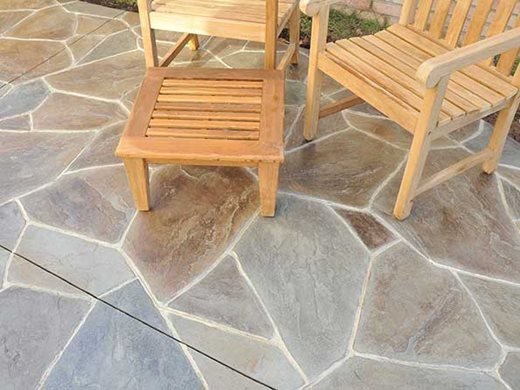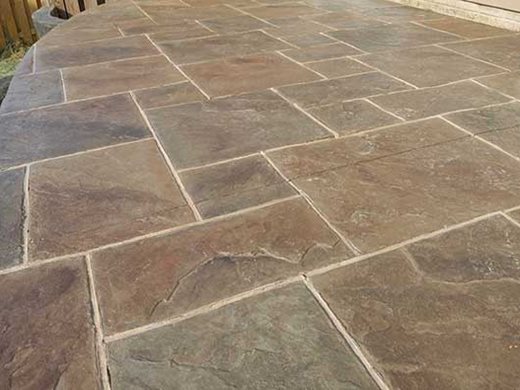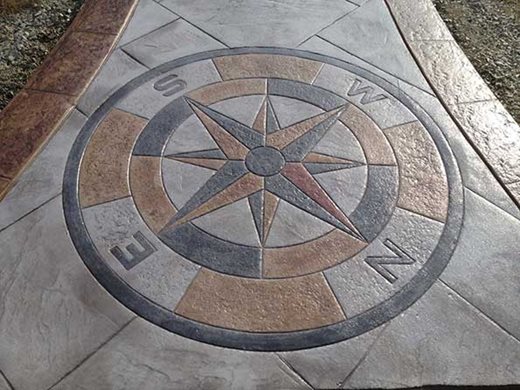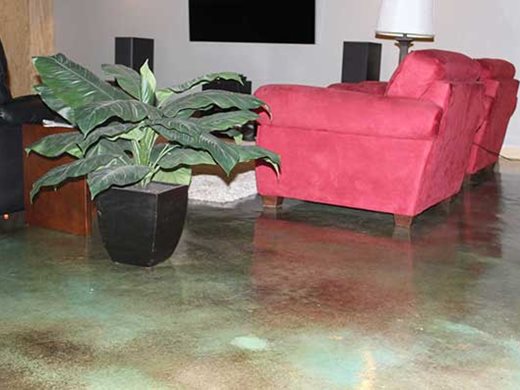Colored stains are a key part of modern decorative concrete designs. Choosing the right color concrete stain is important, but so is choosing the right design. There is far more diversity to the color stain and design available than most people suspect.


There are two general categories that cover dozens of colors of stain. Reactive stains are the oldest kind. They use chemical reactions to permanently change the color of concrete. Reactive stains are also commonly known as acid stains because they often use an acidic ingredient to etch the concrete a facilitate the reaction. Some non-acidic stains do exist on the market for more environmentally friendly and safer use. Penetrating stains deposit pigments in the pores of the concrete. Usually, these are water-based stains but it can also include penetrating dyes that may use acetone.
The color stain creates can vary widely based on the kinds of stains. Acid stains tend to produce earthy colors. Water-based stains are best suited for brighter and pastel color. Dyes often produce bold, bright colors. When choosing the right colors of stain, you need to be aware of what kind of stain you plan on using as well as the design and application. For example, dark earthy colored stains might not work best on a patio around a pool.
Unlock wide possibilities with different patterns and colors of stain. Along with colored stains, stencils, masking, and detail brushes are your friend. To make the most of stained concrete, you must first identify the concrete finish on which the stain will be applied. This determines the techniques that are possible and the most suitable designs. For example, a stamped concrete patio will not work with the same designs and colored stains as a polished concrete floor.
The colors of stain used are influenced by the concrete finish. For example, gray slab with a slate stamp pattern will use different color concrete stain compared to red brick stamped slab. Smooth finish, broom finish, and polished concrete surfaces have more flexibility for design and color selection. For stamped concrete, stains are best used to create natural looking color variation. Using a water-based stain to highlight individual bricks, stones, or tiles creates a realistic appearance.
For smooth finish concrete, there is more flexibility in the color stain used. For these finishes, almost any color stain or stencil pattern will work. You can use a uniform color stain to color the entire surface after placement. Alternatively, you can use multiple colors of stain to create a varied palette. This creates an interesting but easy to maintain design. Smooth finish and polished concrete surfaces can also be stenciled. Whether using an off the shelf commercial stencil or a custom made stencil, stains and dyes are a great method for creating intricate designs and logos.
Installing concrete stains is pretty simple in most cases. Proper surface preparation must be completed before the stain or dye is applied. Concrete should be porous and able to accept the stain. For polished concrete, the stain or dye will be applied before densification for this reason. Stains can be applied using sprayers or brushes. Water-based stains are the most forgiving in installation while acid stains and dyes require more specific processes. Reference the applicable TIS for your chosen concrete staining colors.


Sealing is necessary to protecting the colors of stain after application. For exterior applications of water-based stain, a sealer can prevent the stain from washing out of the concrete. In more permanent or durable cases, the sealer keeps the concrete free of unwanted contamination while enhancing the color. When choosing a sealer, pick one that enhances the color stain creates and provides your desired level of gloss.
Explore impressive concrete installations to find inspiration for your next project.
Find out how much color and fiber you'll need for any size project.